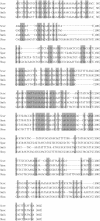De novo origination of a new protein-coding gene in Saccharomyces cerevisiae
- PMID: 18493065
- PMCID: PMC2390625
- DOI: 10.1534/genetics.107.084491
De novo origination of a new protein-coding gene in Saccharomyces cerevisiae
Abstract
Origination of new genes is an important mechanism generating genetic novelties during the evolution of an organism. Processes of creating new genes using preexisting genes as the raw materials are well characterized, such as exon shuffling, gene duplication, retroposition, gene fusion, and fission. However, the process of how a new gene is de novo created from noncoding sequence is largely unknown. On the basis of genome comparison among yeast species, we have identified a new de novo protein-coding gene, BSC4 in Saccharomyces cerevisiae. The BSC4 gene has an open reading frame (ORF) encoding a 132-amino-acid-long peptide, while there is no homologous ORF in all the sequenced genomes of other fungal species, including its closely related species such as S. paradoxus and S. mikatae. The functional protein-coding feature of the BSC4 gene in S. cerevisiae is supported by population genetics, expression, proteomics, and synthetic lethal data. The evidence suggests that BSC4 may be involved in the DNA repair pathway during the stationary phase of S. cerevisiae and contribute to the robustness of S. cerevisiae, when shifted to a nutrient-poor environment. Because the corresponding noncoding sequences in S. paradoxus, S. mikatae, and S. bayanus also transcribe, we propose that a new de novo protein-coding gene may have evolved from a previously expressed noncoding sequence.
Figures






References
Publication types
MeSH terms
Substances
LinkOut - more resources
Full Text Sources
Molecular Biology Databases
Miscellaneous

